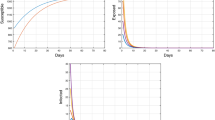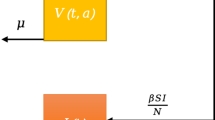Abstract.
For many infectious diseases, a small-world network on an underlying regular lattice is a suitable simplified model for the contact structure of the host population. It is well known that the contact network, described in this setting by a single parameter, the small-world parameter p, plays an important role both in the short term and in the long term dynamics of epidemic spread. We have studied the effect of the network structure on models of immune for life diseases and found that in addition to the reduction of the effective transmission rate, through the screening of infectives, spatial correlations may strongly enhance the stochastic fluctuations. As a consequence, time series of unforced Susceptible-Exposed-Infected-Recovered (SEIR) models provide patterns of recurrent epidemics with realistic amplitudes, suggesting that these models together with complex networks of contacts are the key ingredients to describe the prevaccination dynamical patterns of diseases such as measles and pertussis. We have also studied the role of the host contact strucuture in pathogen antigenic variation, through its effect on the final outcome of an invasion by a viral strain of a population where a very similar virus is endemic. Similar viral strains are modelled by the same infection and reinfection parameters, and by a given degree of cross immunity that represents the antigenic distance between the competing strains. We have found, somewhat surprisingly, that clustering on the network decreases the potential to sustain pathogen diversity.
Similar content being viewed by others
References
D.J. Watts, S.H. Strogatz, Nature 392, 440 (1998)
S. Eubank, H. Guclu, V.S. Anil Kumar, M.V. Marathe, A. Srinivasan, Z. Torockzcai, N. Wang, Nature 429, 180 (2004)
R.A. Anderson, R.M. May, Infectious Diseases of Humans (Oxford U. P., Oxford, 1991)
C. Moore, M.E.J. Newmann, Phys. Rev. E 61, 5678 (2000); C. Moore, M.E.J. Newmann, Phys. Rev. E 62, 7059 (2000)
R. Pastor-Santorras, A. Vespigniani, Phys. Rev. Lett. 86, 3200 (2001); R.M. May, A.L. Lloyd, Phys. Rev. E 64, 066112 (2001)
C.J. Rhodes, R.M. Anderson, J. Theor. Biol. 180, 125 (1996); A. Kleczkowski, B.T. Grenfell, Physica A 274, 355 (1999)
J. Verdasca, M.M. Telo da Gama, A. Nunes, N.R. Bernardino, J.M. Pacheco, M.C. Gomes, J. Theor. Biol. 233, 553 (2005); A. Nunes, M.M. Telo da Gama, M.G.M. Gomes, in press, doi: 10.1016/j-jtbi
R.M. Anderson, R.M. May, R M, Phil. Trans. R. Soc. Lond. B 314, 533 (1986)
P. Grassberger, Math. Biosci. 63, 157 (1983)
A community of N (fixed) individuals comprises, at time t, S susceptibles, I infectives in circulation and R recovered or removed. Constant infection, β, and birth/death, μ, rates are assumed. We consider a square lattice of size N=L2 with periodic boundary conditions. The (random) variables at each site may take one of the values: S, I or R. We account for local connections with k neighbouring sites, with k=12, and long-range connections, with a small world probability, p. Birth, death and infection occur stochastically, with fixed rates (μ, μ, β) while recovery is deterministic after τi time steps. The recovery time sets the time scale
In the SEIR model deterministic recovery occurs after τ l+τi steps. Parameters: life expectancy 61 years or μ=0.000045 day-1
From data available at http://www.zoo.cam.ac.uk/ zoostaff/grenfell/measles.htm
B. Bolker, B.T. Grenfell, Phil. Trans. R. Soc. London B 348, 309 (1995); B.T. Grenfell, O.N. Bjornstad, J. Kappey, Nature 414, 716 (2001)
M.G.M. Gomes, G.F. Medley, D.J. Nokes, D J, Proc. R. Soc. Lond. B 269, 227 (2002)
L.J. Abu-Raddad, N.F. Ferguson, Proc. R. Soc. Lond. B 271, 2431 (2004); M.F. Boni, J.R. Gog, V. Andreasen, F.B. Christiansen, Theor. Popul. Biol. 65, 179 (2004)
D. Gokaydin, J.B. Oliveira-Martins, I. Gordo, M.G.M. Gomes, submitted
C.O.F. Buckee, K. Koelle, M.J. Mustard, S. Gupta, Proceedings of the National Academy of Science 101, 10839 (2004)
T. Nedelea, A. Nunes, M.M. Telo da Gama, work in progress
Author information
Authors and Affiliations
Corresponding author
Rights and permissions
About this article
Cite this article
Telo da Gama, M., Nunes, A. Epidemics in small world networks. Eur. Phys. J. B 50, 205–208 (2006). https://doi.org/10.1140/epjb/e2006-00099-7
Received:
Published:
Issue Date:
DOI: https://doi.org/10.1140/epjb/e2006-00099-7




